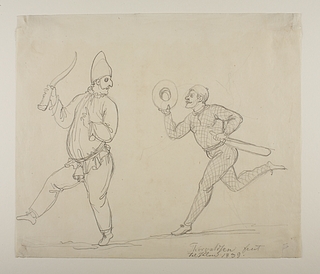
Bertel Thorvaldsen, Pulcinella and Harlekin, 1839, C893.
Bertel Thorvaldsen
Rom
Christian 8.
København
Ingen udskrift, da der er tale om et udkast.
Brevudkastet er ikke dateret. Det er et forlæg til brev af 15.2.1842, og skrevet efter at den tyske prinsesse Luise von Mecklenburg-Strelitz var død den 1.2.1842.
Fifth draft of the letter dated 15.2.1842. The draft later became the object of an exchange between two collectors of Thorvaldsen memorabilia, which is described here.
jeg har haft flere gange den ære at helse paa Storhertuginden af Mecklenborg StrilitzI som yttrede sin store Glæde over de gode EfterretningerII ieg bragte hende fra Deres Majestæt Hun er nu rest herfra den gode Hertuginde og jeg tager her vel megen Deel i den bedrøvelse, som den gode Hertuginde er rest herfra hun har haft et Sørgeligt ophold her i Rom ved at tabe sin kære DatterIII, ieg tager ret megen Deel
I have several times had the honour to greet the grand duchess of Mecklenburg-Strelitz who expressed her great joy at the good news I brought her from Your Majesty The kind duchess has now left and I sympathize very much with the sadness which the kind duchess has left, losing her beloved daughter she has had a sad stay here in Rome, I sympathize very much
[Translated by Karen Husum]
This fifth draft of the letter dated 15.02.1842 from Thorvaldsen to Christian 8. has obviously been cut from a larger piece of paper and now appears as a small strip. This has been placed in an envelope, a piece of folded paper, on which has been written in ink:
“Bertel Thorvaldsen’s hair and handwriting acquired at Nysoe about 1840 from baroness Stampe instead of a Polichinelle drawn in pencil by Thorvaldsen, which I received immediately after he had drawn it when he was encouraged to do so one day at Nysoe”
On the back or the inside of the envelope is written in pencil:
“A. Thorvaldsen’s handwriting. Excerpt of a letter, written in the summer of 1841 in Rome to the King of Denmark -”
In the envelope there is also a small piece of folded blue paper, which contains a golden lock of hair, kept together by red embroidery cotton. The blue paper bears the inscription:
“Bertel Thorvaldsen’s hair. From my stay at Nysoe”.
The envelope with Thorvaldsen’s draft and lock of hair was given as a gift to Thorvaldsens Museum by the regional archives of Funen cf. THM’s journal no. 6 53/1957. The gift also included two poems written by Henrik Stampe for Thorvaldsen’s birthdays 19.11.1842 and 19.11.1843. It all came from Poul Fischer Steenstrup (born 1911), bookseller at Ringe, who for his part had inherited it from a relative Johan Vilhelm August Beck, the former land agent at the manor of Nysoe, where Thorvaldsen lived intermittently with his friends Henrik and Christine Stampe.
Christine Stampe was in Rome with Thorvaldsen and her family from 12.9.1841 to 6.6.1842, and when she was going home, she took the liberty of bringing Thorvaldsen’s fifth draft of the letter dated 15.2.1842, and also the second draft – as well as other “treasures” from the sculptor. Christine Stampe has undoubtedly known about Thorvaldsen’s attempt to write the letter to Christian 8. She has also known the contents, which besides some sad news about the death of the sister of the Danish Crown Princess Mariane and about illness in the Stampe family, among other things deal with the transportation of Thorvaldsen’s art from Rome to Copenhagen, which Thorvaldsen and Stampe had actually gone to Rome to attend to.
Back home at Nysoe, during or after the summer of 1842, Christine Stampe exchanged the draft of the letter she had returned with and a lock of Thorvaldsen’s hair for the pencil drawing of “Polichinelle”, which Thorvaldsen had drawn “one day at Nysoe” and given to the land agent of Nysoe Johan Vilhelm August Beck, according to the provenance of the draft of the letter. It seems probable that Thorvaldsen’s drawing of the Italian commedia dell’arte clown Pulcinella (It) can be indentified as Pulcinella and Harlequin, C893, in Thorvaldsens Museum’s collections. This pencil drawing is dated: “Christmas 1839”, and the motif as well as the date thus agree with Beck’s notes on the envelope, and with the fact that Thorvaldsen was at Nysoe during Christmas 1839. Here, according to Stampe, op. cit., he also made Pulcinellas in cake dough:
“I now brought a big tray on which there was a large sheet of rolled out dough, from which Thorvaldsen with a modelling tool cut out lots of cakes formed as animals, ladies, marcaroni eaters, Policinellas, etc. We baked them and hung them on the Christmas tree, and we competed for them when we were allowed to “plunder” the tree; I still have 10 to 12 of these cakes. […] I am deeply moved when I see them, and I think of the charming childlike innocence with which Thorvaldsen participated in all that the rest of us did, and how he sang with us. He danced when we danced, and on later occasions, when we were sad, for example when we were ill in Rome […] then I learnt that he also wept with those who were sad.”
The pencil drawing of Pulcinella and Harlequin, C893, cf. THM’s journal no. 5 4/1977, has come to Thorvaldsens Museum through the Danish Baron G.F.O. Zytphen – Adeler (1810-1878), Dragsholm Castle in Odsherred – he might very well have acquired it from Christine Stampe.

Bertel Thorvaldsen, Pulcinella and Harlekin, 1839, C893.

|
Pulcinella og Harlekin, 1839, inv.nr. C893 |
Last updated 03.07.2017
The German Grand Duchess Marie von Mecklenburg-Strelitz.
In a letter dated 23.12.1841, Christian 8. had asked Thorvaldsen to inform the Grand Duchess that her youngest daughter, Princess Caroline, was “well and content” in Denmark in her recent marriage to Frederik (7.).
The daughter Luise von Mecklenburg-Strelitz, who had died 1.2.1842, just 24 years old.